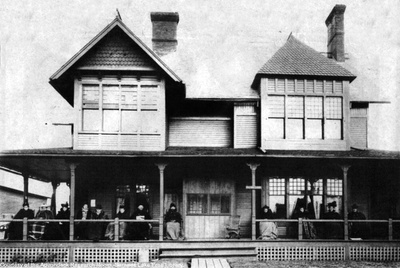 Early curing at the Linwood Cottage— note the absence of cure chairs. Adirondack Daily Enterprise, December 6, 1985
Early curing at the Linwood Cottage— note the absence of cure chairs. Adirondack Daily Enterprise, December 6, 1985 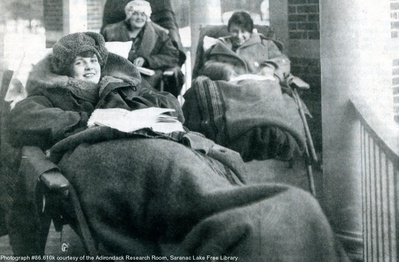 Curing at Ray Brook Sanatorium, undated. Adirondack Daily Enterprise, January 8, 2005
Curing at Ray Brook Sanatorium, undated. Adirondack Daily Enterprise, January 8, 2005 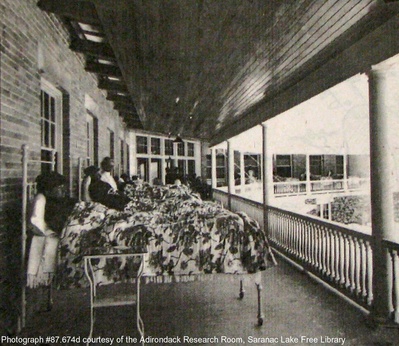 Bed-ridden patients curing at Childs Infirmary, Adirondack Daily Enterprise, May 27, 2000
Bed-ridden patients curing at Childs Infirmary, Adirondack Daily Enterprise, May 27, 2000 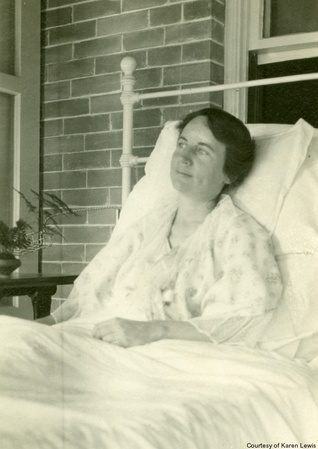 Unknown patient, 1919 "Curing" was the term used for "taking the cure", or being treated in a sanatorium, whether a large establishment, such as the New York State Hospital at Ray Brook, or a smaller commercial private sanatorium, or Cure Cottage. Some even cured in tents.
Unknown patient, 1919 "Curing" was the term used for "taking the cure", or being treated in a sanatorium, whether a large establishment, such as the New York State Hospital at Ray Brook, or a smaller commercial private sanatorium, or Cure Cottage. Some even cured in tents.
The "cure" consisted in resting in fresh air as much as possible, even in bitterly cold weather, combined with a high calorie diet, moderate exercise as able, and keeping the patient's spirits up.
Other elements of the cure had to do with attempts to limit coughing, which could be exhausting, and could lead to hemorrhages in the lung. Cough suppressants, including heroin, were used 1. Pneumothorax involved collapsing the infected lung temporarily by injecting air between the chest wall and the lung; the procedure had to be repeated every few weeks. The lung could be collapsed permanently by an operation in which the phrenic nerve was crushed on one side to paralyse the diaphragm on that side; or by thoracoplasty, an operation in which six to eight ribs were broken and pushed into the thoracic cavity; or by plombage, which involved inserting porcelain balls into the thoracic cavity. 2
Excerpt from an article on the Lent Cottage by Phil Gallos in the Adirondack Daily Enterprise November 11, 1982:
It was early apparent to the medical community in Saranac Lake that a patient's emotional condition had a crucial impact on his or her chances for recovery, and the relationship between patient and family had obvious bearing.
Often these relationships were heartwarming, sometimes heroic. Far too often they were tragic.
Especially prior to the 1930s, the very word "tuberculosis" was almost supernaturally repulsive. Association with the infected was scrupulously avoided and, if it could not be avoided, certainly not acknowledged. The situation amounted to a virtual taboo which held sway in most of the "civilized" world.
This led to much familial anguish. When it was learned a family member had tuberculosis, it was as though the entire family had been stricken; and there arose as many opportunities for cruelty as for love. The cruelty began with suppression and culminated with rejection so total that even after the stricken member had recovered he or she might not be welcomed back into the family — ever. A trend was noticed at Trudeau in which certain patients, after being told they could go home, would become ill again, over and over. One went through the cycle seventeen times — until she married another former patient. To those people, the memory of how things had been at home was more horrible than having the disease. If, though, the relationship between patient and family was positive, the understanding and selfless support of loved-ones was seen to be a powerful adjunct to the curing process. These families were encouraged to stay together. Buildings like the Jennings Cottage provide the needed space.
Whether they were with their families or not, those who came to Saranac Lake to cure became members of a greater family, a family called the village.
Many came too late, their disease too advanced, their remains later shipped out of town on the 9:55 night train. For their survivors, Saranac Lake was a name to forget. But for many others, the village was a place of hope unlike any other place, the antithesis of a world of fear and rejection, a community of people, both healthy and ill, in which a man or woman with tuberculosis would not be shunned as a carrier of contagion but would be accepted as a human being.
This may be the most important single reason why so many, having regained their health, are still living in Saranac Lake.
Plattsburgh Press, May 29, 1906
The "How To Get Well Book," has had so large a sale since the publication of the first edition here in January, that it has been found necessary to have it printed in large numbers in Utica. Mr. Wallace Murray of the Riverside Publishing Company, is contemplating installing presses exclusively for this booklet.
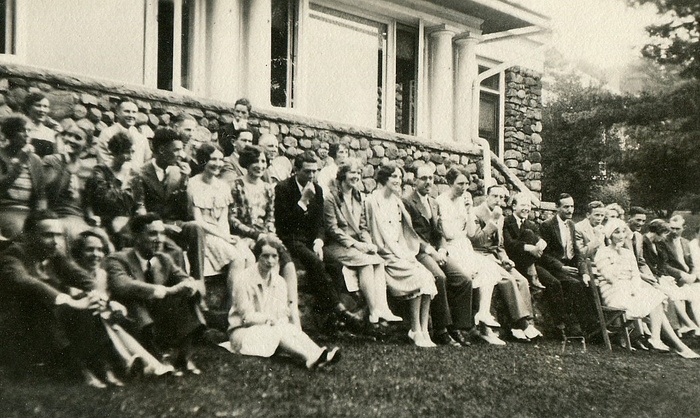 Patients at Trudeau, undated. Courtesy of Janet Dudones. THE CURE AT SARANAC
Patients at Trudeau, undated. Courtesy of Janet Dudones. THE CURE AT SARANAC
THEY call it the open air cure in Saranac (albeit there are those not initiated into the curative degree), but to the outsider it would seem to be the book cure. Everybody is reading most of the time. When they are not they are either talking books or taking their temperature, the latter an art in itself which is developed to a marvellous degree by those who have the chronic Saranac habit. They always talk in tenths these temperature folks do. It is remarkable the way they can divide and subdivide the graduations on the clinic thermometer for which they have paid $1.25 at Kendall's— if you don t get your drugs and things at Kendall's you are like the man from New Orleans who accents the last syllable. They will take their temperature immediately before and after each meal, half way between, and again before they go to bed. If it is 101.1 at three o clock this afternoon, whereas it was 101.2 at the same hour yesterday, a letter is written home about it, the exertion of which immediately increases the temperature a full degree; but this is not known because it won,t be time to take it again until six o clock and then it will have dropped to perhaps 100.7. It does not matter how high the fever may be between times, if it only can be officially recorded low at the stated hours for "taking" it, why, everything is all right. A young woman was "running temperatures" last winter and was put to bed. She wished to go sleighing one afternoon and her physician promised permission provided her temperature would be normal. When she saw him coming to the house on the afternoon in question, she reached out of her open window—one wonders why they have windows in Saranac since they are always open—and broke off an icicle, a piece of which she placed under her tongue. She took the thermometer from the doctor with the utmost confidence, and this time he didn't have to remind her to hold it well under her tongue When the doctor looked at the thermometer he became greatly agitated and the first thing the girl knew she was the centre of a commotion caused by a nurse, maids, and hot water bottles. Pretty soon a saline solution was administered. She then overheard the doctor telling the nurse that the temperature had dropped to 94 and he feared in her frail condition she could not survive such a collapse. The girl was uncertain then whether the icicle played a joke on her or on her doctor. She didn't go sleighing and that doctor didn't call on her again.
But the temperature stunts are only an incident to this story. It is books that strikes the visitor as being the modus operandi of the Saranac cure. It does not matter whether or not you ever have read a line in your life, if you go to the Adirondacks as an invalid you will be reading before you know it, and, what is worse, you will get to talking about what you read. You may be a splendid bricklayer, and have gone along plying your trade for years oblivious of Robert Louis Stevenson, but you won't be in Saranac a day until you have heard that Stevenson spent a winter there, and the second day you will be writing home for The Master of Ballantrae or else buying it at "The Book Store," provided your allowance is not too limited. The reason you chose The Master of Ballantrae is that you have been told that Stevenson wrote it over there on Baker's stoop. Stevenson troubled that stoop of Baker's very little during the winter he boarded at the cottage. In fact, he was anything but a faithful taker of the cure. However, he was a celebrity, had been to Saranac, and Saranac will never forget him. They also read everything available about Frank Ives, the billiard player, who, like Stevenson spent a winter in Saranac, and later, unlike Stevenson, chose Arizona instead of Samoa to die in. By and by, if any publisher is enterprising enough to print "The Letters of a Self-Made Jockey to His Boss," by Danny Maher there is sure to be sufficient sale for it in Saranac alone to defray the expense of the first edition, because Danny gets enough "cure" in the village every winter to last him during the racing season. David Harum is of course a great favourite among the invalids not because it is David Harum but because poor Westcott took the cure at Meacham Lake and died. Then there is Cooper, and the members of the Philosophers' Camp of long ago on the Lower Saranac—Lowell, Emerson, Stillman, and the rest. And how philosophically a motorman may be seen delving into the Fable for Critics just as serious as though he was making the turn at Union Square, more so perhaps because at Union Square the motorman does not care, but in Saranac he does care, because he knows that there you are judged by what you read.
There is, of course, not enough "local" reading to go round, and so the authors directly associated with the Adirondacks form only a portion of the aggregate wisdom that is daily absorbed. The village has its circulating library, and there is another library at Dr. Trudeau's sanitarium. Both of these contain standard works and also the current novels. A man who was a fine carpenter before his health "broke down," and whose reading previous to his trip to Saranac had been confined to the newspapers with the biggest headlines, may be seen to spend an hour in the library looking for a book he thinks he will like. He will pass by Will Carlton and Mr. Dooley, although his name may be Pat Keefe; will glance at the volume on the Dickens shelf, may read a line or two in Vanity Fair and then he deliberately will take down Kant's Critique of Pure Reason and carry it to his cottage, confident that he has a work worth reading. He will then put in a couple of weeks of as hard work as he ever did on a scaffolding.
Off in a lonely corner of a cottage porch, a young girl who "broke down" in an East Side sweatshop and is "taking the cure" through the courtesy of some charitable organization, has a bulky volume of Balzac on her knees—as droll a spectacle as any character she can be reading about. A coachman is reading Les Miserables. He had never read Black Beauty. A stenographer is poring over a translation of the Aeneid although on the very shelf from which she took the volume was the Enchanted Typewriter, but she didn't see anything in that title to attract her. Then too, as an observer remarked at the time ,Virgil is a much quieter name than Bangs and the doctor told her to do quiet reading.
And so it goes throughout the resort. Every one is reading and most of them chose the last books in the world one would pick out for them. Many instances could be cited just the reverse of those that have been told. A professor in a well known university spent an entire winter reading Mr. Potter of Texas, and other such yellow backed novels. A literary woman of considerable attainment confined her reading the same winter to newspapers. An actor spent a winter reading the Bible, searching for the derivation of Hall Caine, perhaps. A ballet dancer spent her time studying Shakespeare and often didn't cut the wrappers of The Metropolitan and The Clipper which she received regularly by mail. This, however, was only in keeping with the Saranac idea, which if it cannot cure is certain to develop impossible ambitions.
As might be expected, the health colony is also a relentless consumer of new books and magazines, but comparatively few newspapers are read. Somehow the average New Yorker cannot tolerate a morning paper at eight in the evening—that is the time the morning papers reach the resort, unless the single track road north of Utica, of the greatest railroad system in the world, is doing things (which it generally is), in which case the papers won't arrive until the following morning.
Next to Stevenson the champion author in Saranac is Beatrice Harraden, and well she may be, for in Ships That Pass in the Night there is presented the daily story of the Adirondack health resort. Read Saranac for Petershof, the Adirondacks for the Alps, and no other change would be necessary to set the mournful but fascinating Swiss romance on this side of the Atlantic, The disagreeable man is in Saranac—he is there by the dozen; so is Mrs Reffold—she is at every boarding house and every one, unless something more than his lungs be affected, can pick out a Bernardine. Then there is Warli the dwarf; who ever entered the Saranac post office for a couple of years back without seeing him at the register letter department?— and those registered letters mean as much to the invalids in Saranac as they did in Petershof. They may mean so many sleigh rides a week, or none at all, or they may mean "Zinfandel" for dinner, instead of "Pomery."
Some of the invalids after a time acquire something of a literary knack. A quantity of harmless and amusing rhyme is turned out, some of which is clever. Most of this is done by persons who never discovered that they had such a talent until they got to Saranac (and so the burdens of the place multiply). One popular rhyme has the cheerful title of "The Last Lament of a Lingering Lunger," and it was written by a man who vows it was his first offense in alliteration—"lunger," it may be explained, is Saranacese for consumptive—it is certainly as logical and not nearly so hopeless a term. A young woman, suffering with a high fever and headache, wrote one night, limericks with a stanza for each letter of the alphabet. She never had any pretensions as a rhymster before, but hit off some features of the life which can be recognised at once by any invalid who ever put up in the village—put up is the only term that expresses what it is to be an invalid and to be in Saranac. Two stanzas are:
C was a curious cure
Consisting of air fresh and pure
Inhale it for say
Twenty six hours every day
And health you will surely secure
V was a versatile village
Where neither stock raising nor tillage
So appealed to the heart
As the exquisite art
Of devising new methods of pillage.
And with it all, some get better, while all learn how to read
—Edmund Ryan.
WATCH Curiously Adirondack: The Adirondack Mountain Village of Saranac Lake Remembers Its Curative Past produced by Josh Clement and Ed Kanze.
Most of us have heard William Faulkner's famous line about the past not being dead. His wisdom is nowhere more apparent than in the Adirondack Mountain village of Saranac Lake. Here, from the 1880s to the 1950s and a little bit beyond, tuberculosis patients arrived from near and far to rest on porches, breathe crisp pine-scented mountain air, and get well or die trying. Antibiotic therapy eventually put the village's sanitariums and cure cottages out of business. Still, in architecture, memory, story, and a heart-breaking poem penned by a brilliant young woman who didn't get well, the village's rich past remains vibrant and alive.
A 1964 letter from Bill Campbell to Jeremy Blanchet contained the following limerick:
A lady whose name was McClure
Has spent 40 years on the Cure
When the doctor said, "Well,
It's too early to tell
But I'd stay 40 more to make sure."
Artifacts
- Cure Chairs
- Family Scrapbooks and Albums
- Rules and Information for Patients
- Sputum Cups
- Stone Pigs (Hot water bottles)
- Cure Cottage Museum
See also:
Comments
Footnotes
1. See articles on Lawrason Brown and George Jarvis
2. Wikipedia - Tuberculosis - Surgical treatment



